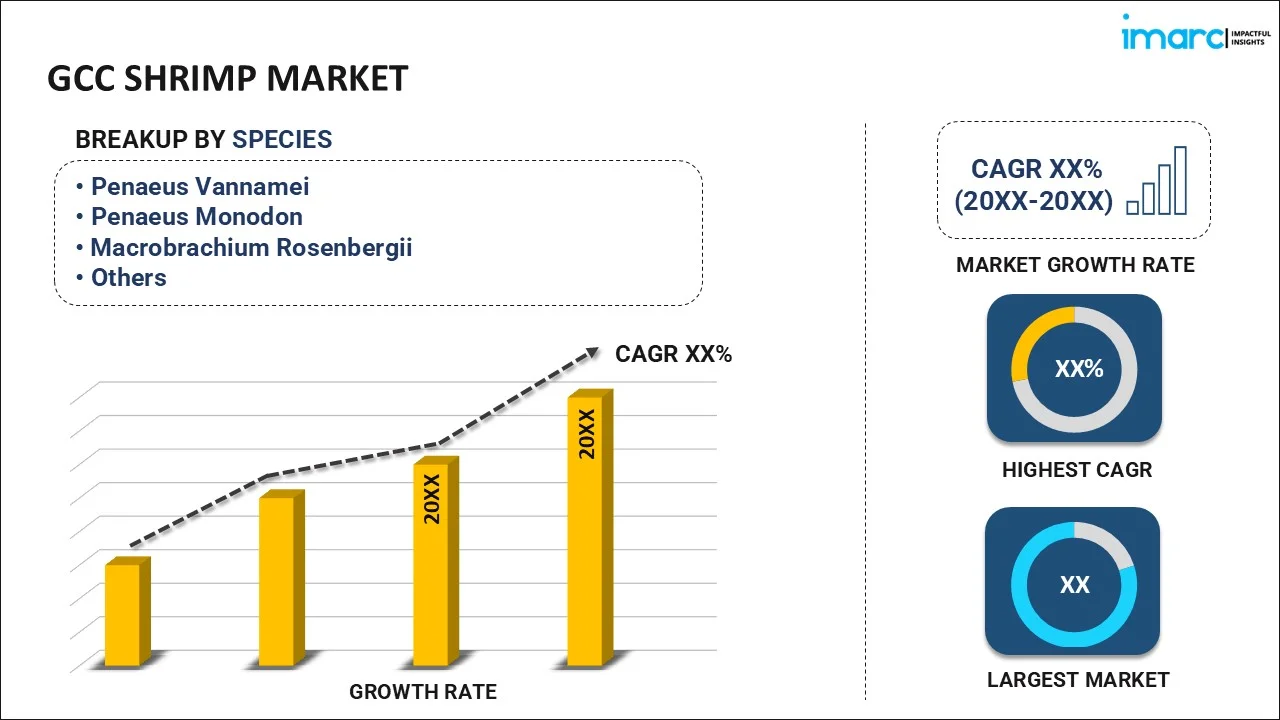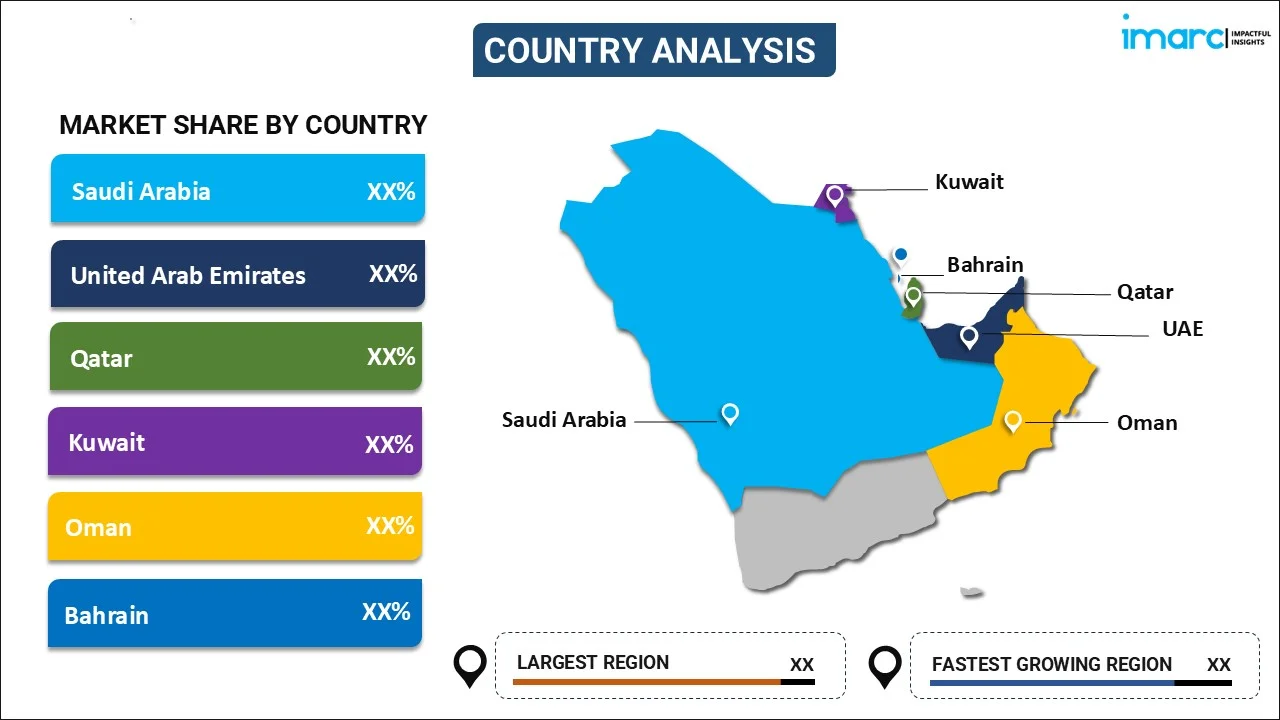
GCC Shrimp Market Report by Species (Penaeus Vannamei, Penaeus Monodon, Macrobrachium Rosenbergii, and Others), Shrimp Size (Size <21, Size 21-25, Size 26-30, Size 31-40, Size 41-50, Size 51-60, Size 61-70, Size >70), Distribution Channel (Hypermarkets and Supermarkets, Convenience Stores, Hotels and Restaurants, Online Sales, and Others), and Country 2025-2033
Market Overview:
The GCC shrimp market size reached USD 824.8 Million in 2024. Looking forward, IMARC Group expects the market to reach USD 1,255.8 Million by 2033, exhibiting a growth rate (CAGR) of 4.1% during 2025-2033. The rapid economic growth and consumer demand, growing population, and tourism, rising aquaculture development, trade liberalization and agreements, increasing health and nutrition awareness and significant technological advancements represent some of the key factors driving the market.
|
Report Attribute
|
Key Statistics
|
|---|---|
|
Base Year
|
2024 |
|
Forecast Years
|
2025-2033
|
|
Historical Years
|
2019-2024
|
| Market Size in 2024 | USD 824.8 Million |
| Market Forecast in 2033 | USD 1,255.8 Million |
| Market Growth Rate (2025-2033) | 4.1% |
Shrimp is a crustacean belonging to the order Decapoda and the infraorder Caridea. This small, aquatic creature is widely distributed across various marine and freshwater environments and plays a significant role in both ecological and economic contexts. Shrimp typically has an elongated body with a well-developed exoskeleton, which provides protection and support. Its distinguishing features include a segmented body, ten legs, and a pair of pincers known as chelae. In culinary traditions worldwide, shrimp is highly prized for its succulent taste and versatility in various dishes. It is often harvested and consumed as seafood, adding a delectable flavor to cuisines ranging from Asian stir-fries to Mediterranean paellas. Additionally, shrimp serves as a rich source of high-quality protein, low in fat, and provides essential nutrients like selenium, vitamin B12, and phosphorus. Shrimp also plays a vital role in marine ecosystems as both predators and prey, contributing to nutrient cycling and helping maintain ecological balance.
GCC Shrimp Market Trends:
The GCC countries have experienced significant economic growth over the years, resulting in rising disposable incomes and improved standards of living. As a consequence, there has been an increase in consumer demand for high-quality and diverse seafood products, including shrimp, driving the overall market growth. Additionally, the region has witnessed substantial population growth, along with a surge in international tourism. These factors have led to an increased demand for seafood products, particularly in hotels, restaurants, and catering services, further stimulating the market. Other than this, with a rise in demand for seafood, including shrimp, the aquaculture industry has witnessed considerable investments and advancements in the GCC region. Governments and private entities have been promoting sustainable aquaculture practices, which has led to a boost in domestic shrimp production, thus reducing reliance on imports. In line with this, the GCC countries have engaged in various trade agreements to foster international cooperation and reduce trade barriers. Such agreements have facilitated smoother imports and exports of shrimp, contributing to market growth and diversification of product offerings. Besides this, growing health consciousness among consumers has prompted a shift toward healthier food choices. Shrimp, being a low-fat and protein-rich seafood option, has gained popularity among health-conscious consumers, further bolstering its market demand. Furthermore, advancements in fishing and aquaculture technologies have improved shrimp production efficiency and quality. Additionally, the development of a robust cold chain infrastructure ensures the preservation of shrimp during storage and transportation, enabling the supply of fresh and frozen shrimp products across the region. Moreover, governments in the GCC region have implemented policies and regulations to ensure sustainable seafood practices and maintain food safety standards. These initiatives not only promote responsible fishing but also create a conducive environment for market growth.
GCC Shrimp Market Segmentation:
IMARC Group provides an analysis of the key trends in each segment of the GCC shrimp market report, along with forecasts at the regional and country levels for 2025-2033. Our report has categorized the market based on species, shrimp size, and distribution channel.
Species Insights:

- Penaeus Vannamei
- Penaeus Monodon
- Macrobrachium Rosenbergii
- Others
The report has provided a detailed breakup and analysis of the market based on species. This includes Penaeus Vannamei, Penaeus Monodon, Macrobrachium Rosenbergii, and others.
Shrimp Size Insights:
- Size <21
- Size 21-25
- Size 26-30
- Size 31-40
- Size 41-50
- Size 51-60
- Size 61-70
- Size >70
A detailed breakup and analysis of the market based on the shrimp size has also been provided in the report. This includes size <21, size 21-25, size 26-30, size 31-40, size 41-50, size 51-60, size 61-70, and size >70.
Distribution Channel Insights:
- Hypermarkets and Supermarkets
- Convenience Stores
- Hotels and Restaurants
- Online Sales
- Others
The report has provided a detailed breakup and analysis of the market based on distribution channel. This includes hypermarkets and supermarkets, convenience stores, hotels and restaurants, online sales, and others.
Country Insights:

- Saudi Arabia
- UAE
- Qatar
- Oman
- Kuwait
- Bahrain
The report has also provided a comprehensive analysis of all the major regional markets, which include Saudi Arabia, the UAE, and Qatar, Oman, Kuwait, and Bahrain.
Competitive Landscape:
The report has also provided a comprehensive analysis of the competitive landscape in the market. Competitive analysis such as market structure, key player positioning, top winning strategies, competitive dashboard, and company evaluation quadrant has been covered in the report. Also, detailed profiles of all major companies have been provided.
GCC Shrimp Market Report Coverage:
| Report Features | Details |
|---|---|
| Base Year of the Analysis | 2024 |
| Historical Period | 2019-2024 |
| Forecast Period | 2025-2033 |
| Units | Million USD |
| Scope of the Report | Exploration of Historical and Forecast Trends, Industry Catalysts and Challenges, Segment-Wise Historical and Predictive Market Assessment:
|
| Species Covered | Penaeus Vennamei, Penaeus Monodon, Macrobrachium Rosenbergii, Others |
| Shrimp Sizes Covered | Size <21, Size 21-25, Size 26-30, Size 31-40, Size 41-50, Size 51-60, Size 61-70, Size >70 |
| Distribution Channels Covered | Hypermarkets and Supermarkets, Convenience Stores, Hotels and Restaurants, Online Sales, Others |
| Countries Covered | Saudi Arabia, UAE, Qatar, Bahrain, Kuwait, Oman |
| Customization Scope | 10% Free Customization |
| Post-Sale Analyst Support | 10-12 Weeks |
| Delivery Format | PDF and Excel through Email (We can also provide the editable version of the report in PPT/Word format on special request) |
Key Questions Answered in This Report:
- How has the GCC shrimp market performed so far and how will it perform in the coming years?
- What has been the impact of COVID-19 on the GCC shrimp market?
- What is the breakup of the GCC shrimp market on the basis of species?
- What is the breakup of the GCC shrimp market on the basis of shrimp size?
- What is the breakup of the GCC shrimp market on the basis of distribution channel?
- What are the various stages in the value chain of the GCC shrimp market?
- What are the key driving factors and challenges in the GCC shrimp market?
- What is the structure of the GCC shrimp market and who are the key players?
- What is the degree of competition in the GCC shrimp market?
Key Benefits for Stakeholders:
- IMARC’s report offers a comprehensive quantitative analysis of various market segments, historical and current market trends, market forecasts, and dynamics of the GCC shrimp market from 2019-2033.
- The research study provides the latest information on the market drivers, challenges, and opportunities in the GCC shrimp market.
- Porter's five forces analysis assist stakeholders in assessing the impact of new entrants, competitive rivalry, supplier power, buyer power, and the threat of substitution. It helps stakeholders to analyze the level of competition within the GCC shrimp industry and its attractiveness.
- Competitive landscape allows stakeholders to understand their competitive environment and provides an insight into the current positions of key players in the market.
Need more help?
- Speak to our experienced analysts for insights on the current market scenarios.
- Include additional segments and countries to customize the report as per your requirement.
- Gain an unparalleled competitive advantage in your domain by understanding how to utilize the report and positively impacting your operations and revenue.
- For further assistance, please connect with our analysts.
 Inquire Before Buying
Inquire Before Buying
 Speak to an Analyst
Speak to an Analyst
 Request Brochure
Request Brochure
 Request Customization
Request Customization




.webp)




.webp)












